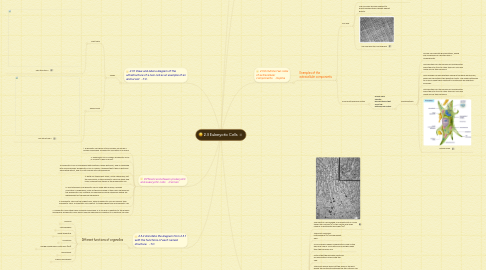
1. 2.3.1 Draw and label a diagram of the ultrastructure of a liver cell as an example of an animal cell -T.C.
1.1. Types
1.1.1. Plant cells
1.1.1.1. Cell structure I
1.1.2. Animal cells
1.1.2.1. Cell structure II
2. Differences between prokaryotic and eukaryotic cells -Carmen
2.1. 1. Eukaryotic cells have a true nucleus, bound by a double membrane. Prokaryotic cells have no nucleus.
2.2. 2. Eukaryotic DNA is linear; prokaryotic DNA is circular (it has no ends).
2.3. 3. Eukaryotic DNA is complexed with proteins called "histones," and is organized into chromosomes; prokaryotic DNA is "naked," meaning that it has no histones associated with it, and it is not formed into chromosomes.
2.4. 4. Both cell types have many, many ribosomes, but the ribosomes of the eukaryotic cells are larger and more complex than those of the prokaryotic cell.
2.5. 5. The cytoplasm of eukaryotic cells is filled with a large, complex collection of organelles, many of them enclosed in their own membranes; the prokaryotic cell contains no membrane-bound organelles which are independent of the plasma membrane.
2.6. 6. Eukaryotic cells are the largest cells, while Prokaryotic cells are smaller than Eukaryotic cells. A eukartotic cell is about 10 times bigger than a prokaryotic cell.
2.7. 7. Eukaryotic cells either have a plasma membrane or a cell wall in addition to the plasma membrane; prokaryotic cells have a plasma membrane in addition to a bacterial cell wall.
3. 2.3.2 Annotate the diagram from 2.3.1 with the functions of each named structure. -T.C.
3.1. Different functions of organelles
3.1.1. Nucleus
3.1.1.1. This is the largest of the organelles. The nucleus contains the chromosomes which during interphase are to be found the nucleolus.
3.1.2. Mitochondria
3.1.2.1. Location of aerobic respiration and a majot synthesis of ATP region
3.1.3. Golgi apparatus
3.1.3.1. Modification of proteins prior to secretion.
3.1.4. Lysozyme
3.1.4.1. Vesicles in the above diagram that have formed on the golgi apparatus. Containing hydrolytic enzymes. Functions include the digestion of old organelles, engulfed bacteria and viruses.
3.1.5. Rough endoplasmic reticulum (rER)
3.1.5.1. Protein synthesis and packaging into vesicles.
3.1.6. Ribosomes
3.1.6.1. Tthe free ribosome produces proteins for internal use within the cell.
3.1.7. Plasma membrane
3.1.7.1. Controls which substances can enter and exit a cell. It is a fluid structure that can radically change shape.
4. It protects and maintains the shape of plant cells as well as providing a filtering mechanism to keep the cells from over-expanding with water.
5. State differences between plant and animal cells- Carmen
5.1. 1.Plant cells are larger than animal cells.
5.2. 2.Plant cells have chloroplasts unlike animal cells
5.3. 3.Plant cells have a cell wall unlike animal cells.
5.4. 4.Animal cells have a lot of lysosomes unlike plant cells.
5.5. 5.Animal cells have a centrosome unlike plant cells
5.6. 6.Plant cells have plasticids unlike animal cells
5.7. 7.Vacuoles are conspicuous in plant cells than animal cells
5.8. 8. Animal cells can be phagocytic (engulf other cells) unlike plant cells
5.9. 9.Cells of Higher plants lack centrioles unlike animal cells.
5.10. 10.Plant cells have plasmodesmata which links pores in the cell wall allow and communication between adjacent cells unlike animal cells
5.11. Nuevo nodo
5.11.1. Nuevo nodo
6. 2.3.6 Outline two roles of extracellular components. -Sophia
6.1. Examples of the extracellular components
6.1.1. Cell wall
6.1.1.1. The plant cell wall is a rigid structure that surrounds cells.
6.1.1.2. The cell walls provide support to plants holding them upright against gravity.
6.1.1.3. Cell wall electron micorgraph
6.1.2. Animal extracellular matrix
6.1.2.1. animal cells secrete glycoproteins that form the extracellular matrix
6.1.2.1.1. Glycoproteins
